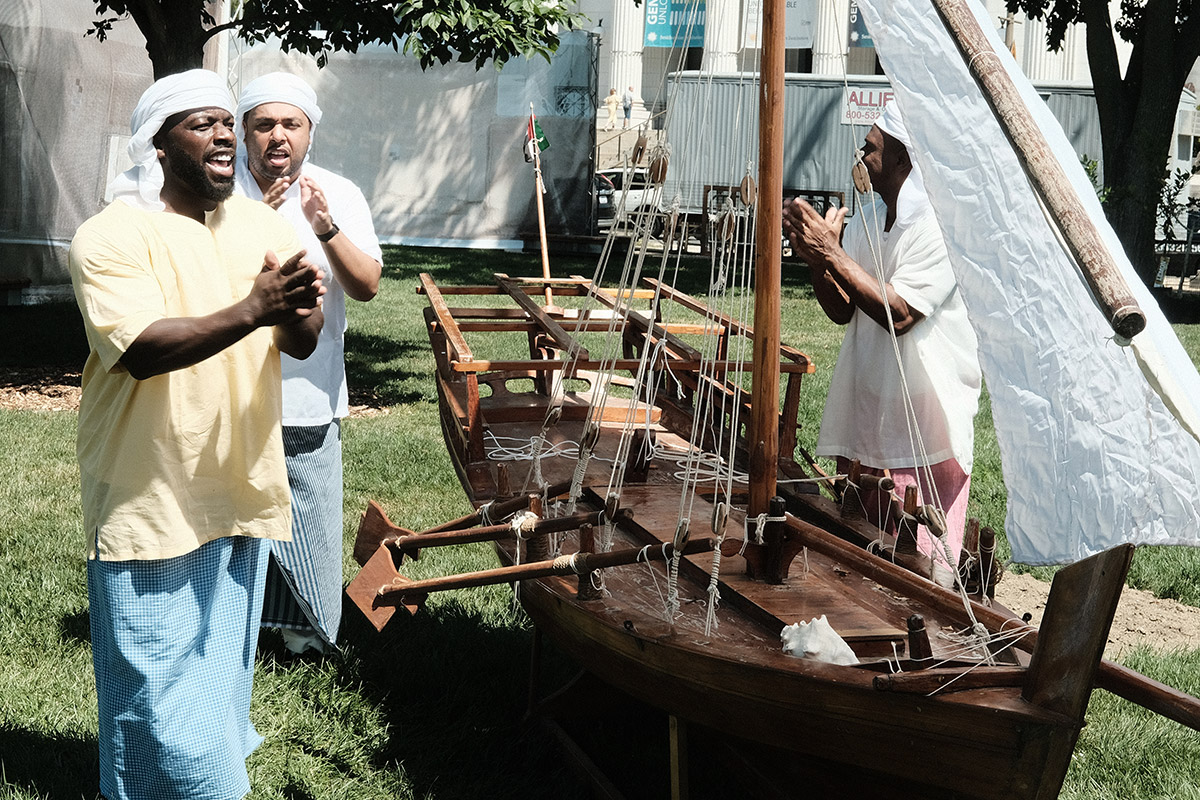A Brief History of Pearl Diving Music

Pearl singers at the 2022 Folklife Festival
Photo by Aaron Crabtree, Ralph Rinzler Folklife Archives
Pearl diving music is in Juma Al Jneibi’s blood. Men in his family have sung and clapped in the quintessential polyrhythms of fijiri—or Arab sea music—for generations.
“We saw our fathers, our grandfathers doing this with smiles, with less stress,” Al Jneibi says in Arabic, translated by Mustafa Al Fardan, himself an expert in pearl merchant heritage. “This is why we love it.”
Fijiri is a vocal music sung by pearl divers on wooden dhows as entertainment and inspiration. It typically features one main singer, called a nahham, who is joined by a chorus singing, clapping, and drumming. Today, the nahams no longer lead crews of divers but are instead preservationist artists, protecting and maintaining the tradition.
For centuries, millennia even, people in the Gulf region have free-dived for the tiny shimmering pearls tucked inside oysters settled on the seabed. Before Japanese cultured pearls swept the market in the 1930s, many Gulf economies were fueled by the pearling industry. United Arab Emirates University scholar K. Aqil estimates that before World War II, eighty percent of the UAE’s workers were in some way engaged in the pearling industry, whether as divers or ship builders or something else.

Many of the divers who filed onto pearling dhows, set to sail for four months at a time, were enslaved by wealthy merchants. As the industry began to cave, British agents, stationed around the Gulf due to their imperial “protectorate” system, began offering manumission, or a release from slavery, if individuals could come to their offices and prove abuse. The Runaways Enslaved and Manumitted on the Arabian Peninsula (REMAP) database organizes manumission applicants by the primary place they were enslaved in and includes narrative statements by British agents.
Hundreds of applicants from the UAE fill the REMAP tables. I click on the records for a thirty-year-old man called Khamis bin Abdur Rahman, his application dated November 18, 1934. He was enslaved in Dubai from birth, his parents enslaved by the same master. As soon as he “became strong enough to do so,” his master sent him on pearl-diving trips with all the earnings funneled back to his enslaver. Bin Abdur Rahman testified that his master “gave me very little food and clothing, and I also used to receive insults and ill treatment” at his hands.
This history is largely unspoken today (the Bin Jelmood House in Doha being a notable exception), but the records are not silent. I scroll through file after file documenting abuse. Some were kidnapped from Northeast Africa (Sudan, Ethiopia, Tanzania) and sold into slavery. Others were from the Gulf, some even from India or Pakistan. There are records of shark attacks from diving, hearing loss, and other water pressure-related ailments.
With crewmembers spending months at sea, separated from their family by miles of choppy seawater, morale could easily dip low on dhows. Pearl diving music emerged as a component of work culture for the all-male crews. Fijiri bands played to rhythms divers and haulers (those who pulled divers out of the water with ropes) could settle into while singing of home and people left behind. Since “home” wasn’t one region, the songs include elements of Bedouin, East African, Persian, and Indian rhythmic styles, all blended. There are hundreds of different types of songs in the traditional repertoire, but most begin sets with a slower pattern, which progresses into a near-frantic peak and then settles back to a slow pace.
Hear more from Smithsonian Folkways Recordings
Living through traumatizing experiences without family support systems, divers found a spiritual lifeline in music. According to Bahraini musician and ethnomusicologist Hasan Hujairi, many songs are about love, God, memory, disappointments, death, loss, and joy—essentially reflections on the human experience.
“To reduce, to release someone from the stress of life, let them go with music,” Al Jneibi says. Al Jneibi plans to teach his children to play this music as a form of grounding. “They will be happy and I can control them better. At least help them stay away from drugs or from alcohol or other things that might hurt them.”
This summer, Al Jneibi performs at the Smithsonian Folklife Festival, as part of the United Arab Emirates program, with Ali Al Hammadi and Naji Al Alawi. The professional musicians play weddings and community celebrations, but this is their first time on National Mall in Washington, D.C.
As if drawn by a magnet, crowds form at the sounding of a conch trumpet. The band’s set begins. Al Jneibi sings the main melody while Al Hammadi and Al Alawi drum and sing in response. Most of the crowd doesn’t understand Arabic, but their tone and sound is enough to mesmerize. Some start clapping, keeping up with the men’s steady rhythm. Others dance, their hips moving with the drum beats as if on instinct. Fijiri cuts through the chatter of surrounding stations and captivates the crowd.
“We like when people dance with us, because it has an international rhythm,” Fardan says.
The band performs daily at the Festival in the Story Majlis and Crossroads Stage. All are invited to listen, clap, and dance.

Hannah Davis is a multimedia documentation intern at the Smithsonian Center for Folklife and Cultural Heritage and a rising senior at Carleton College, majoring in political science/ international relations.
Audio recording and editing by Dave Walker, Ralph Rinzler Folklife Archives.

